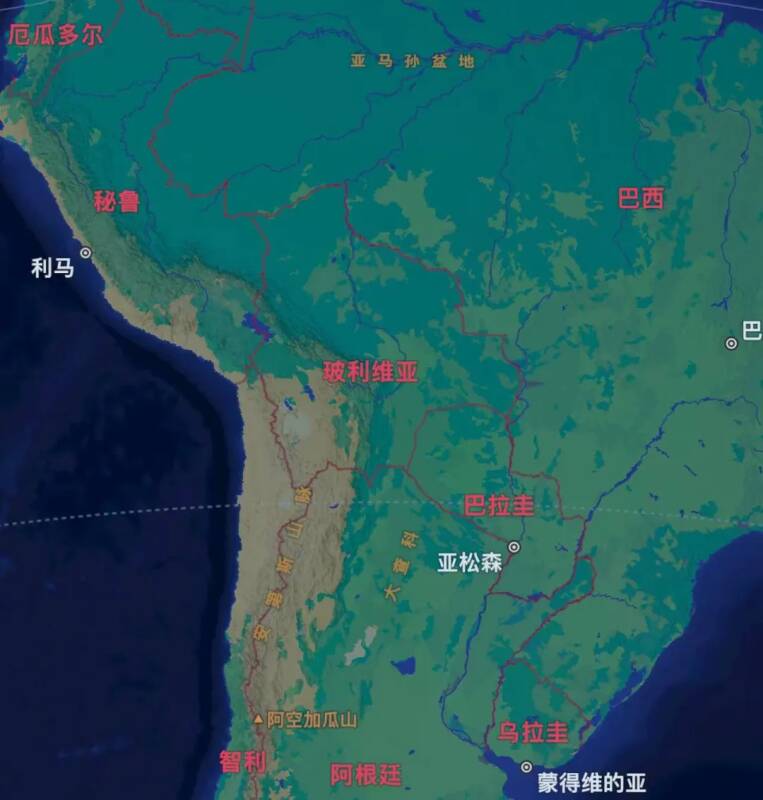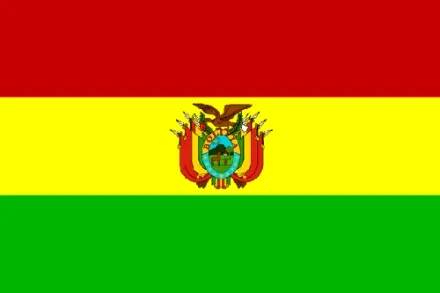Introduction to varieties grown in the coffee producing area of Bolivia in South America
South America is a diversified continent, which is rich in natural resources, so it has many coffee producing countries, such as Colombia, Ecuador, Brazil, Peru, Bolivia and so on.
Bolivia Bolivia
The Plurinational State of Bolivia (Estado Plurinacional de Bolivia) is a landlocked country located in central South America, surrounded by Brazil, Peru, Chile, Argentina and Paraguay, with a land area of 1.098 million square kilometers and rich in natural resources.

The Bolivian national flag is rectangular and consists of three parallel rectangles of red, yellow and green from top to bottom. In the past, red symbolized sacrifice for the country, yellow symbolized hope, and green symbolized the sacred land, but now it represents the animals, minerals and plants of Bolivia.
The Bolivian national flag used on formal occasions is painted with the national emblem in the center. The national emblem is oval in the middle, with the sun, mountain peaks, bread trees, camel sheep and grain patterns on the round surface. "Bolivia" is written in Spanish on the edge of the circle, and there are ten five-pointed stars in the lower half. represents the nine provinces that make up Bolivia and the coastal provinces that have been seized by Chile. There are three national flags on each side, with sticks and weapons crossed behind them, symbolizing authority. There are also vultures at the top, symbolizing strength and freedom, and bay twigs and olive branches on both sides, representing the people's pride in national freedom and the desire of many countries to live in harmony.

The east and northeast of Bolivia are mostly alluvial plains of the Amazon River, accounting for 60% of the country's area. the central part is a valley area, which belongs to the eastern foothills of the Andes, where agriculture is well developed, and many important cities are concentrated here. To the west is the Bolivian plateau, with an average elevation of more than 1000 meters.
Bolivia has a diverse climate, with three climatic zones, the tropical plain (average temperature 25 ℃), the valley bottom (average temperature 18 ℃) and the plateau (average temperature 10 ℃). These climates have made coffee one of the main cash crops in the country.
Coffee producing area
The producing area is mainly concentrated in the Yungas district of Yonggas, where 95% of the coffee is produced in Bolivia, where the infrastructure is relatively backward and lacks large washing plants. When the coffee is ripe, farmers have to pick the ripe fruit and immediately transport it to La Paz, which is higher than the area for processing. The road through La Paz in Yonggas is steep, through a total length of 90 kilometers, climbing from 1200 meters above sea level to 4650 meters above sea level. The mountain road, which is at least 3 hours' drive and has no protective measures, is known as the "death road".
Yonggas Yungas: located on the eastern side of the Andes, it is a rugged agricultural area. It is the oldest producing area in Bolivia. The capital La Paz is located just west of Yungas. Coffee is grown here between 800 and 2500 meters above sea level and is harvested from July to November every year. The coffee produced in this area usually has a deep and full sweetness, soft citrus acidity and black fruit and berry flavors.
Copacabana Copacabana: located in the western part of the country, near Lake Titicaca. The moist air in this producing area provides excellent conditions for the growth of coffee. Lake Titicaca is also one of the highest lakes in the world, with an average annual temperature of about 10-14 degrees Celsius. This means that coffee in this producing area has the advantage of altitude and temperature in the first place.
La Bascaravina La Paz Caranavi: located to the north of Yonggas, this producing area is also located in the hills of the Andes, but does not reach the same high altitude as Yonggas. Caravina's average altitude is 1500 meters above sea level, so the coffee produced here is a little less complex and has more chocolate flavor.
Coffee variety
Bolivia mainly grows iron pickup, Kaddura and a special coffee variety, Java.
Java: this variety was introduced to the Indonesian island of Java from Ethiopia in the early 19th century and was originally thought to be a Typica variety. Later, it was brought to Cameroon and was considered resistant to coffee berry disease before being introduced to Central and South American countries. Java has long fruits and seeds, brass buds, high plants but low yields. Because of its outstanding flavor, it has stronger resistance to leaf rust and coffee fruit disease, so it is very suitable for small farmers.
Important Notice :
前街咖啡 FrontStreet Coffee has moved to new addredd:
FrontStreet Coffee Address: 315,Donghua East Road,GuangZhou
Tel:020 38364473
- Prev

The popularity of fruit coffee is rising, but Starbucks is selling tea?!
▲ Click to pay attention| Daily Boutique Coffee Culture Magazine Coffee Factory Nowadays, consumers 'tastes are becoming more and more picky. In order to catch consumers' attention, chain brands have made different tricks on the new product innovation track, and various drinks have been put on shelves one after another. However, recently, some consumers have noticed that Starbucks 'new products, which are mainly coffee, are actually
- Next

Big courage! Starbucks is actually "sarcastic" with customers?!
▲ Click to pay attention| What will your first feeling be when you receive a smiling emoticon sent to you during the daily boutique coffee culture magazine coffee workshop online chat? Yesterday, after receiving Starbucks takeout, a customer took out his drink from his packaging bag as usual, but the packaging cup that came into view was covered with a yellow table.
Related
- Being chased out of the rain in front of Starbucks?! Store: Sheltering from rain under umbrellas poses a safety hazard
- The white moonlight has changed?! Lucky launches "Big Winter Pear American"
- Hand-brewed coffee three-stage method, high-sweet and universal brewing method to share! What does the high sweet water level of hand-brewed coffee mean?
- What is the difference between raw, refined and full espresso coffee? How to extract espresso and taste good?
- A complete list of coffee bean names and their meanings! What is Yejia Shefi coffee? Where is Mantelin coffee?
- What grade does Arida Manor Kaduai coffee beans belong to? What treatment is Arida ASD slow anaerobic sun exposure?
- The milk tea cup becomes smaller?! Overlord Tea Girl launches a new "Return to Yunnan" series
- Accused of selling counterfeit and high-priced coffee beans! Well-known boutique coffee brand "Oukelao" bowed and apologized!
- How to make espresso dumplings? Can I eat coffee and glutinous rice balls together?
- Save the unformed and stagnant powder cakes in one second! What is the problem with stagnant water in the powder bowl of the espresso machine?

